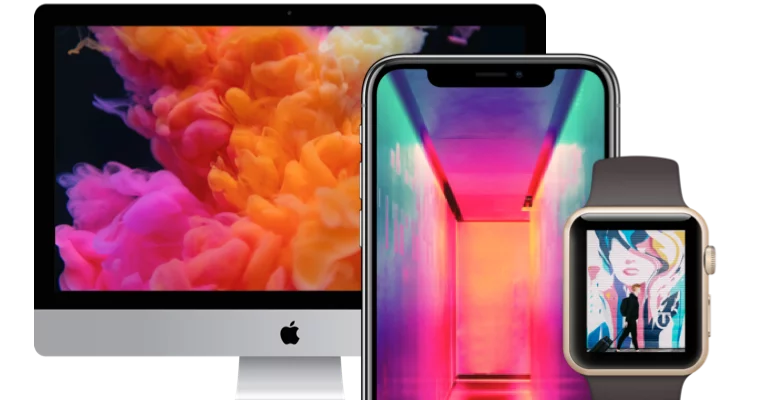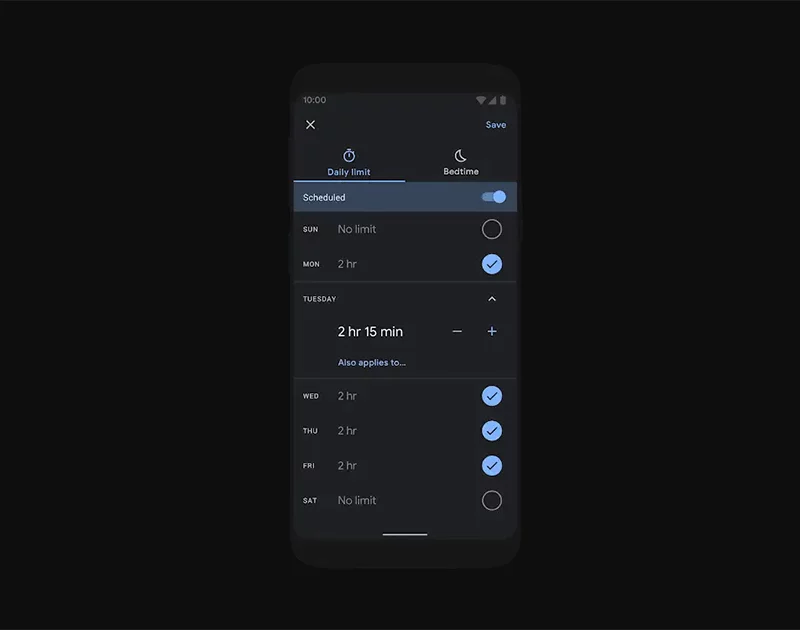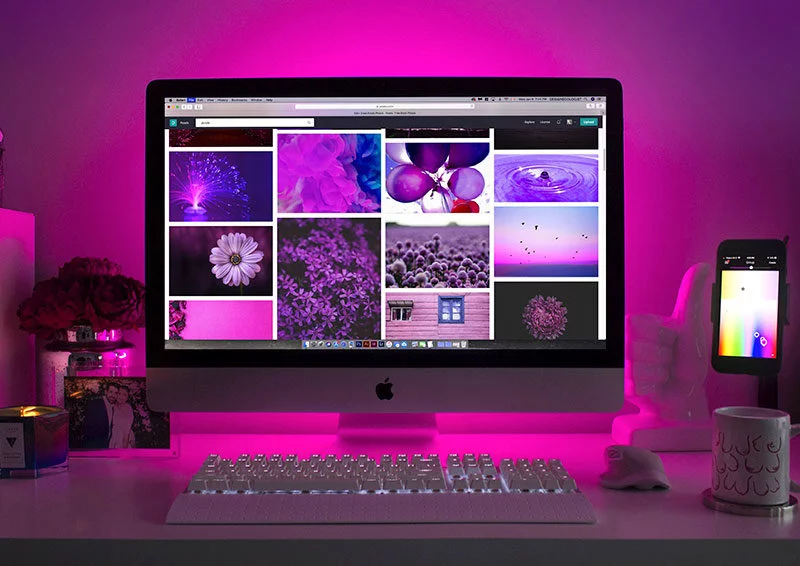In 2D screens, such as computer monitors and mobile phones, the size of the screen (also known as the viewport) is the physical size of the area where the images and videos are displayed. The size of the screen is usually described by the length of its diagonal, which is the distance between the opposite corners, usually in inches. It is also sometimes called the physical size of the image to distinguish it from the “logical size of the image”, which describes the resolution of the screen and is measured in pixels.
Screen resolution vs pixel density
The resolution or display modes of a digital TV, computer monitor or display device is the number of distinct pixels in each measure that can be displayed. This can be an ambiguous term, especially since the display resolution is controlled by various factors in cathode ray tubes (CRT), flat panel (including liquid crystal) and projection displays using fixed array imaging elements (pixels).
For the display of devices such as phones, tablets, monitors and televisions, the use of the term display resolution, as defined above, is incorrect, although common. The term display resolution is commonly used to refer to pixel size, the maximum number of pixels in each measurement (e.g., 1920 × 1080), which says nothing about the pixel density of the display in which the image is actually formed: the resolution correctly refers to pixel density, the number of pixels per unit of distance or area, and not the total number of pixels. In digital measurements, the resolution of the display will be given in pixels per inch (PPI). In analog measurement, if the screen height is 10 inches, the horizontal resolution is measured in 10 square inches.f For television standards, this is usually indicated as “horizontal resolution lines by the height of the image”; for example, analog NTSC televisions can normally display about 340 lines “by the height of the image” of horizontal resolution from above-air sources, which is equivalent to about 440 common lines of actual image information from left to right.
The history of “screen size”
The method of measuring screen size along its diagonal was inherited from the method used in the first generation of CRT TVs, when circular edge photo tubes were widely used. Because they are round, the outer diameter of the bulb was used to describe its dimensions. As these round tubes were used to display rectangular images, the diagonal measurement of the visible rectangle was smaller than the diameter of the tube due to the thickness of the glass surrounding the phosphor screen (which was hidden from the viewfinder by the body and the bezel). This method continued even when the cathode ray tubes were made in the form of rounded rectangles; its advantage was that it was a unique number that determined the size and was not confusing when the aspect ratio was universal 4:3. In the USA, when almost all TV tubes had a 4:3 aspect ratio, the screen size was defined as the true diagonal of the screen with a V following it (this was a requirement in the USA market, but not in other countries). In almost all other markets, the outer diameter of the tube was specified. What was 27V in the USA may have been 28 inches elsewhere. However, in advertising in the USA the terminology V was often omitted, citing 27V as 27 inches. This was not misleading to the consumer because the law required the seller to specify the actual size of the screen. Flat panels, on the contrary, use the actual diagonal of their visible size so that the size is the actual size presented to the viewer in all markets. This means that a similar sized screen will be larger than a flat panel screen compared to a cathode ray tube screen.
When the overall aspect ratio increased from 4:3 to 16:9, the new widescreen screens in the US were marked with the letter W. The display, which is approximately 27 W high, will have an output power of 32 W. Vizio and other U.S. TV manufacturers have introduced even larger screens with a 21:9 aspect ratio to match the aspect ratio used in movie theaters. To evaluate the relative size of these new screens, it is necessary to consider the aspect ratio of the screen. In a commercial market where different aspect ratios are sold, two numbers are always needed to describe the screen size, some combination of diagonal, aspect ratio, height or width.

Dimensions are often given as a “class” because screens from different manufacturers will have small differences in size. However, the “class” must be less than 1/2″ of the actual size. The reasons for differences in size within a class are due to differences in the manufacturers’ equipment. As manufacturers change from one size to another, larger sizes should fit in the same size as the glass, although with fewer monitors cut from it. Some sizes fit well and maximize the use of glass, others fit worse and waste glass. For example, in some cases, increasing the screen size by up to 0.1 inches may cause the LCD manufacturer to move from 12 screens mounted on their glass sheets to 9, which will make them uncompetitive compared to other screen manufacturers.
Screen Size Comparison
To illustrate the point, here is a comparison chart we’ve developed of all modern (popular) phones, tablets and wearables. This screen size comparison chart shows the screen resolution and the pixel density of each device as well as other metrics like the CSS width.
| name | phys. width | phys. height | css width | css height |
|
|---|---|---|---|---|---|
| Amazon Kindle Fire | 600 | 1024 | 600 | 1024 | |
| Amazon Kindle Fire HD 7 | 800 | 1280 | 480 | 800 | |
| Amazon Kindle Fire HD 8.9 | 1200 | 1920 | 800 | 1280 | |
| Apple iPad 1, 2 | 768 | 1024 | 768 | 1024 | |
| Apple iPad 3, 4, Air, Air2 | 1536 | 2048 | 768 | 1024 | |
| Apple iPad mini | 768 | 1024 | 768 | 1024 | |
| Apple iPad mini 2, 3, 4 | 1536 | 2048 | 768 | 1024 | |
| Apple iPad Pro | 2048 | 2732 | 1024 | 1366 | |
| Apple iPad Pro 9.7 | 1536 | 2048 | 768 | 1024 | |
| Apple iPhone 3 | 320 | 480 | 320 | 480 | |
| Apple iPhone 4 | 640 | 960 | 320 | 480 | |
| Apple iPhone 5 | 640 | 1136 | 320 | 568 | |
| Apple iPhone 6+, 6s+, 7+, 8+ | 1080 | 1920 | 414 | 736 | |
| Apple iPhone 6, 6s | 750 | 1334 | 375 | 667 | |
| Apple iPhone 7, iPhone 8 | 750 | 1334 | 375 | 667 | |
| Apple iPhone X | 1125 | 2436 | 375 | 812 | |
| Apple iPod Touch | 640 | 1136 | 320 | 568 | |
| Asus Nexus 7 (v1) | 800 | 1280 | 604 | 966 | |
| Asus Nexus 7 (v2) | 1080 | 1920 | 600 | 960 | |
| Blackberry Classic | 720 | 720 | 390 | 390 | |
| Blackberry Leap | 720 | 1280 | 390 | 695 | |
| Blackberry Passport | 1440 | 1440 | 504 | 504 | |
| Blackberry Playbook | 600 | 1024 | 600 | 1024 | |
| Blackberry Q10 | 720 | 720 | 346 | 346 | |
| Blackberry Torch 9800 | 360 | 480 | 360 | 480 | |
| Blackberry Z10 | 768 | 1280 | 384 | 640 | |
| Blackberry Z30 | 720 | 1280 | 360 | 640 | |
| Google Glass | 640 | 360 | 427 | 240 | |
| HTC 8X | 720 | 1280 | 320 | 480 | |
| HTC Evo 3D | 540 | 960 | 360 | 640 | |
| HTC Nexus 9 | 1538 | 2048 | 768 | 1024 | |
| HTC One | 1080 | 1920 | 360 | 640 | |
| Lenovo K900 | 1080 | 1920 | 360 | 640 | |
| LG G3 | 1440 | 2560 | 360 | 640 | |
| LG G4 | 1440 | 2560 | 360 | 640 | |
| LG G5 | 1440 | 2560 | 360 | 640 | |
| LG G Pad 8.3 | 1200 | 1920 | 600 | 960 | |
| LG Nexus 4 | 768 | 1280 | 384 | 640 | |
| LG Nexus 5 | 1080 | 1920 | 360 | 640 | |
| LG Optimus G | 768 | 1280 | 384 | 640 | |
| Microsoft Lumia 620 | 480 | 800 | 320 | 480 | |
| Microsoft Lumia 830 | 720 | 1280 | 320 | 480 | |
| Microsoft Lumia 900 | 480 | 800 | 320 | 480 | |
| Microsoft Lumia 920 | 768 | 1280 | 320 | 480 | |
| Microsoft Lumia 925 | 768 | 1280 | 320 | 480 | |
| Microsoft Lumia 1020 | 768 | 1280 | 320 | 480 | |
| Microsoft Lumia 1520 | 1080 | 1920 | 432 | 768 | |
| Microsoft Surface | 768 | 1366 | 768 | 1366 | |
| Microsoft Surface Pro | 1080 | 1920 | 720 | 1280 | |
| Microsoft Surface Pro 2 | 1080 | 1920 | 720 | 1280 | |
| Microsoft Surface Pro 3 | 1440 | 2160 | 1024 | 1440 | |
| Motorola Nexus 6 | 1440 | 2560 | 412 | 690 | |
| Pantech Vega n°6 | 1080 | 1920 | 360 | 640 | |
| Samsung Galaxy Nexus | 720 | 1200 | 360 | 600 | |
| Samsung Galaxy Note | 800 | 1280 | 400 | 640 | |
| Samsung Galaxy Note 2 | 720 | 1280 | 360 | 640 | |
| Samsung Galaxy Note 3 | 1080 | 1920 | 360 | 640 | |
| Samsung Galaxy Note 4 | 1440 | 2560 | 360 | 640 | |
| Samsung Galaxy Note 8 | 1440 | 2960 | 360 | 740 | |
| Samsung Galaxy Note 9 | 1440 | 2960 | 360 | 740 | |
| Samsung Galaxy Note 10 | 1080 | 2280 | 360 | 718 | |
| Samsung Galaxy Note 10+ | 1080 | 2280 | 360 | 718 | |
| Samsung Galaxy S | 480 | 800 | 320 | 533 | |
| Samsung Galaxy S2 | 480 | 800 | 320 | 533 | |
| Samsung Galaxy S3 | 720 | 1280 | 360 | 640 | |
| Samsung Galaxy S3 mini | 480 | 800 | 320 | 533 | |
| Samsung Galaxy S4 | 1080 | 1920 | 360 | 640 | |
| Samsung Galaxy S4 mini | 540 | 960 | 360 | 640 | |
| Samsung Galaxy S5 | 1080 | 1920 | 360 | 640 | |
| Samsung Galaxy S6 | 1440 | 2560 | 360 | 640 | |
| Samsung Galaxy S7, S7 edge | 1440 | 2560 | 360 | 640 | |
| Samsung Galaxy S8 | 1440 | 2960 | 360 | 740 | |
| Samsung Galaxy S8+ | 1440 | 2960 | 360 | 740 | |
| Samsung Galaxy S9 | 1440 | 2960 | 360 | 740 | |
| Samsung Galaxy S9+ | 1440 | 2960 | 360 | 740 | |
| Samsung Galaxy S10 | 1440 | 3040 | 360 | 740 | |
| Samsung Galaxy S10+ | 1440 | 3040 | 360 | 740 | |
| Samsung Galaxy Tab 2 10" | 800 | 1280 | 800 | 1280 | |
| Samsung Galaxy Tab 2 (7") | 600 | 1024 | 600 | 1024 | |
| Samsung Galaxy Tab 3 10" | 800 | 1280 | 800 | 1280 | |
| Samsung Galaxy Tab (8.9") | 800 | 1280 | 800 | 1280 | |
| Samsung Nexus 10 | 1600 | 2560 | 800 | 1280 | |
| Sony Xperia P | 540 | 960 | 360 | 640 | |
| Sony Xperia S | 720 | 1280 | 360 | 640 | |
| Sony Xperia Z | 1080 | 1920 | 360 | 640 | |
| Sony Xperia Z3 | 1080 | 1920 | 360 | 598 | |
| Xiaomi Mi 3 | 1080 | 1920 | 360 | 640 | |
| Xiaomi Mi 4 | 1080 | 1920 | 360 | 640 | |
| Xiaomi Redmi Note 5 | 1080 | 2160 | 393 | 786 | |
| ZTE Grand S | 1080 | 1920 | 360 | 640 | |
| ZTE Open (Firefox OS) | 480 | 720 | 320 | 480 |







